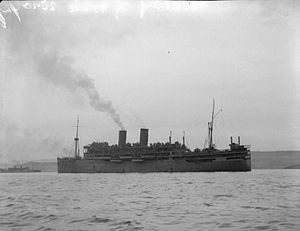RMS Viceroy of India

As HMS Viceroy of India on the Clyde in World War II
|
|
| History | |
|---|---|
|
|
|
| Name: | RMS Viceroy of India |
| Namesake: | Viceroy & Governor-General of India |
| Owner: |
|
| Operator: |
|
| Port of registry: |
|
| Route: | Tilbury — Bombay |
| Builder: | Alexander Stephen and Sons, Glasgow |
| Cost: | £1,090,987 |
| Yard number: | 519 |
| Laid down: | April 1927 |
| Launched: | 15 September 1928 |
| Christened: | By Dorothy, Countess of Halifax, wife of the 1st Earl of Halifax, Viceroy of India |
| Completed: | March 1929 |
| Maiden voyage: | 7 March 1929 |
| In service: | 7 March 1929 |
| Out of service: | 11 November 1942 |
| Homeport: | Tilbury |
| Identification: |
|
| Fate: | sunk 11 November 1942 by U-407 |
| General characteristics | |
| Class and type: | ocean liner |
| Tonnage: | |
| Length: |
|
| Beam: | 76.2 ft (23.2 m) |
| Draught: | 28 ft 2.75 in (8.60 m) |
| Depth: | 41.5 ft (12.6 m) |
| Decks: | 5 |
| Installed power: |
|
| Propulsion: | |
| Speed: | 19 knots (35 km/h) or 20 knots (37 km/h) |
| Capacity: |
|
| Crew: |
|
| Sensors and processing systems: |
direction finding equipment |
RMS Viceroy of India was an ocean liner of the Peninsular and Oriental Steam Navigation Company (P&O). She was a British Royal Mail Ship on the Tilbury–Bombay route and was named after the Viceroy of India. In World War II she was converted to and used as a troopship. She was sunk in the Mediterranean in November 1942 by German submarine U-407.
P&O ordered the ship from Alexander Stephen and Sons of Glasgow in 1927. She was originally to be called Taj Mahal, after the 17th-century mausoleum of Mumtaz Mahal in Agra. She was laid down in April 1927, launched in September 1928 and completed in March 1929. She cost £1,090,987
She had six water-tube boilers with a combined heating surface of 32,500 square feet (3,019 m2) that supplied steam at 400 lbf/in2 to two turbo generators. These supplied current to electric motors with a combined rating of 3,565 NHP that drove twin screw propellers.British Thomson-Houston (BT-H) of Rugby, Warwickshire built the turbo-generators and motors.
Each turbo-generator ran at 2,690–3,110 RPM, producing three-phase current at 2,720 volts and rated at 900 kW. Each propeller shaft was driven by two three-phase 3,150 volt electric motors running at 109 RPM and giving 8,500 shp (6,300 kW) per shaft. At reduced power of up to 11,600 shp (8,700 kW) only one turbo-generator was needed to supply current to both motors, thus maximising fuel economy. Variation of propeller speed in either direction was achieved by changing the turbine speed.
...
Wikipedia
